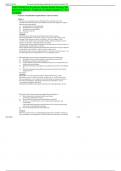9/24/23, 9:55AM Psychiatric mentalhealthnursing8theditionbyvidebecktestbank[1389] about:blank 1/334 TEST BANK For Psychiatric Mental Health Nursing, 9th Edition by Sheila L. Videbeck | Verified Chapter's 1 - 24 | Complete Psychiatric -MentalHealthNursing8theditionby VidebeckTestBank Chapter1 1. The nurse is assessing the factors contributing to the well-being of a newly admitted client. Whichofthefollowingwouldthenurseidentifyashavingapositiveimpacto
ntheindividual'smentalhealth? A) Notneedingothersforcompanionship B) Theability toeffectivelymanagestress C) Afamilyhistory ofmentalillness D) Striving for total self -
reliance Ans: B Feedback: Individual factors influencing mental health include biologic makeup, autonomy, independence, self-esteem, capacity for growth, vitality, ability to find meaning in life, emotional resilience or hardiness, sense of belonging, reality orientation, and coping orstress management abilities. Interpersonal factors such as intimacy and a balance ofseparatenessandconnectedness arebothneededforgoodmentalhealth,andthereforea healthy person would need others for companionship. A family history of mental illnesscouldrelatetothebiologicmakeupofanindividual,whichmayhaveanegativeimpacton an individual's mental health, as well as a negative impact on an individual'sinterpersonal and socialñcultural factors of health. Total self -reliance is not possible, andapositivesocial/culturalfactor isaccess toadequateresources. 2. Which ofthefollowingstatementsaboutmentalillnessaretrue?Selectallthatapply. A) Mentalillnesscancausesignificantdistress,impairedfunctioning,orboth. B) Mentalillnessisonlyduetosocial/cultural factors. C) Social/culturalfactorsthatrelatetomentalillnessincludeexcessivedependencyonor withdrawalfromrelationships. D) Individuals sufferingfrommentalillnessareusuallyabletocopeeffectivelywithdailyl
ife. E) Individuals sufferingfrommentalillnessmayexperiencedissatisfaction withrelat
ionships and self. Ans: A,D, E Feedback: Mental illness can cause significant distress, impaired functioning, or both. Mental illness may be related to individual, interpersonal, or social/cultural factors. Excessivedependency on or withdrawal from relationships are interpersonal factors that relate tomental illness. Individuals suffering from mental illness can feel overwhelmed with dailylife.Individuals suffering frommentalillnessmayexperiencedissatisfactionwithrelationships and self. 3. Whichofthe followingaretrueregardingmentalhealthandmentalillness? A) Behaviorthatmaybeviewedasacceptableinonecultureis alwaysunacceptableinother cultures. B) Itiseasytodetermineifapersonismentallyhealthyormentallyill. C) In most cases, mental health is a state of emotional, p sychological, and social wellness evidencedbysatisfyinginterpersonal relationships,effectivebehaviorandcoping,p
ositiveself -concept,andemotionalstability. D) Personswhoengageinfantasiesarementallyill.An
s: C Feedback: Whatonesocietymayviewas acceptableand appropriatebehavior,anothersocietymaysee that as maladaptive, and inappropriate. Mental health and mental illness are difficultto 9/24/23, 9:55AM Psychiatric mentalhealthnursing8theditionbyvidebecktestbank[1389] about:blank 2/334 define precisely. In most cases, mental health is a state of emotional, psychological,and social wellness evidenced by satisfy ing interpersonal relationships, effectivebehaviorandcoping,positiveself -
concept,andemotionalstability.Personswhoengagein fantasies may be mentally healthy, but the inability to distinguish reality from fantasyis anindividualfactor thatmaycontributetomenta lillness. 4. Aclientgrievingtherecentlossofherhusbandasksifsheisbecomingmentallyillbecause
sheissosad. The nurse'sbestresponsewould be, A) ìYoumayhaveatemporarymentalillness becauseyou areexperiencingsomuchpain.î B) ìYouarenotmentallyill.Thisisanexpectedreactionto thelossyouhaveexperie
nced.î C) ìWereyou generallydissatisfied withyourrelationshipbeforeyourhusband's death?î D) ìTrynottoworryaboutthatrightnow. Younever knowwhatthefuturebrings.îAns: B Feedback: Mental illness includes general dissatisfaction with self, ineffec tive relationships,ineffective coping, and lack of personal growth. Additionally the behavior must not beculturally expected. Acute grief reactions are expected and therefore not consideredmentalillness.Falsereassuranceoroveranalysisdoesnotaccuratelyaddres sthecli
ent'sconcerns. 5. ThenurseconsultstheDSMforwhichofthefollowingpurposes? A) Todeviseaplanofcareforanewlyadmittedclient B) Topredicttheclient'sprognosisoftreatmentoutcomes C) Todocumenttheappropriatediagnosticcodeintheclient'smedicalrecord D) To serve as a guide for client assessmentAns: D Feedback: The DSM provides standard nomenclature, presents defining characteristics, andidentifies underlying causes of mental disorders. It does not provide care plans orprognostic outcomes of treatment. Diagnosis of mental ill ness is not within thegeneralistRN's scopeofpractice,sodocumenting thecodeinthemedicalrecord wouldbeinappropriate. 6. Whichwouldbe a reasonfora student nurse touse the DSM? A) Identifying themedicaldiagnosis B) Treatclients C) Evaluatetreatments D) Understandthereasonfor theadmissionandthenatureofpsychiatricillnesses.Ans: D Feedback: Although student nurses do not use the DSM to diagnose clients, they will find it ahelpful resource to understand the reason for the admission and to begin buildingknowledgeaboutthenatureofpsy chiatricillnesses.Identifyingthemedicaldiagno
sis,treating,and evaluatingtreatmentsarenotapartofthenursing process. 7. Thelegislationenactedin1963waslargelyresponsibleforwhichofthefollowing shiftsincarefor thementallyill? A) Thewidespreaduseofcommunity -based ser vices B) Theadvancementinpharmacotherapies C) Increasedaccesstohospitalization D) Improvedrightsforclientsinlong -
terminstitutionalcareAns: A Feedback: TheCommunityMentalHealthCenters ConstructionActof1963accomplishedtherelease of individuals from long -term stays in state institutions, the decrease inadmissions to hospitals, and the development of community -based services as analternativetohospitalcare. 9/24/23, 9:55AM Psychiatric mentalhealthnursing8theditionbyvidebecktestbank[1389] about:blank 3/334 8. Whichoneofthefollowingisaresultoffederallegislation? A) Makingiteasiertocommitpeopleformentalhealthtreatmentagainstt heirwill. B) Makingitmoredifficulttocommitpeopleformentalhealthtreatmentagainsttheir
will. C) Statementalinstitutionsbeingtheprimarysourceofcareformentallyillpersons. D) Improvedcareformentallyillpersons.A
ns: B Feedback: Commitment laws changed in the early 1970s, m aking it more difficult to commitpeople for mental health treatment against their will. Deinstitutionalizationaccomplished the release of individuals from long -term stays in state institutions. Deinstitutionalization alsohadnegativeeffects inthatsomementally illpersonsare subjected totherevolvingdooreffect,whichmaylimit
careformentallyillpersons. 9. Thegoalofthe1963 CommunityMentalHealthCentersActwasto A) ensure patients'rightsforthementallyill. B) deinstitutionalize statehospitals. C) providefundstobuildhospitalswith psychiatricunits. D) treatpeoplewithmentalillnessinahumanefashion.Ans
: B Feedback: The 1963 Community Mental Health Centers Act intimated the movement towardtreating those with mental illness in a less restrictive environment. This legislationresulted in the shift of clients with mental illness from large state institutions to carebased in the community. Answer choices A, C, and D were not purposes of the 1963CommunityMentalHealthCentersAct. 10. Thecreationofasylumsduring the1800swasmeantto A) improvetreatmentofment aldisorders. B) provide foodandshelterforthementallyill. C) punishpeoplewithmentalillness whowerebelieved tobepossessed. D) removedangerouspeoplewithmentalillnessfromthecommunity.Ans
: B Feedback: Theasylumwas meanttobeasafehavenwithfood, shelter,andhumanetreatment forthementallyill.Asylumswerenotusedtoimprovetreatmen
tofmentaldisorders ortopunish mentally ill people who were believed to be possessed. The asylum was notcreatedtoremovethedangerouslymentallyillfromthecommunity. 11. Themajorproblemswithlargestateinstituti onsare:Selectallthatapply. A) attendantswereaccused ofabusingtheresidents. B) stigmaassociatedwithresidenceinaninsaneasylum. C) clients weregeographically isolatedfromfamilyandcommunity. D) increasing financialcoststoindividualresidents.A
ns: A, C Feedback: Clientswere oftenfarremovedfromthelocalcommunity,family,andfriendsbecausestate institutions were usually in rural or remote settings. Choices B and D were notmajorproblemsassociated withlargestateinstructions. 12. Asignificantchangeinthetreatmentofpeoplewithmentalillnes soccurredinthe1950swhen A) communitysupportservices wereestablished. B) legislation dramaticallychangedcivilcommitmentprocedures. C) thePatient'sBillofRightswasenacted. 9/24/23, 9:55AM Psychiatric mentalhealthnursing8theditionbyvidebecktestbank[1389] about:blank 4/334 D) psychotropicdrugsbecameavailableforuse.A
ns: D Feedback: Thedevelopmentofpsychotropicdrugs,or drugs used totreatmentalillness,beganinthe1950s. Answer choicesA, B, and C did notoccur inthe1950s. 13. Beforetheperiodoftheenlightenment,treatmentofthementallyillincluded A) creatinglargeinstitutionstoprovidecustodialcare. B) focusingonreligiouseducationtoimprovet heirsouls. C) placingthementallyillondisplayforthepublic'samusement. D) providingasaferefugeorhavenofferingprotection.An
s: C Feedback: In 1775, visitors at St. Mary's of Bethlehem were charged a fee for viewing andridiculing the mentally ill, who were seen as animals, less than human. Custodial carewas not often provided as persons who were considered harmless were allowed towander in the countryside or live in rural communities, and more dangerous lunaticswere imprisoned, chained, and starved. In early Christi an times, primitive beliefs andsuperstitions were strong. The mentally ill were viewed as evil or possessed. Priestsperformedexorcisms toridevilspirits,andinthecolonies,witchhuntswereconductedwith offenders burned at the stake. It was not until the period of enlightenment whenpersons who were mentally ill were offered asylum as a safe refuge or haven offeringprotectionatinstitutions. 14. Thefirsttrainingofnurses toworkwithpersons withmentalillness was in1882inwhichstate? A) California B) Illinois C) Massachusetts D) New YorkAns: CFeedback: Thefirsttrainingfornurses toworkwithpersons withmentalillnesswas in1882atMcLeanHospitalinBelmont, Massachusetts. 15. Whatismeantbythetermìrevolvingdooreffectîinmentalhealthcare? A) Anoverallreductioninincidenceofseverementalillness B) Shorteran dmorefrequenthospitalstays forpersons withsevereandpersistentmentalillness C) Flexible treatmentsettingsformentallyill D) MosteffectiveandleastexpensivetreatmentsettingsAn
s: B Feedback: Therevolvingdooreffectreferstoshorter,butmorefrequent,hospitalstays.Clients arequickly discharged into the community where services are not adequate; withoutadequate community services, clients become acutely ill and require rehospitalization.Therevolvingdooreffectdoesnotrefertoflexibletreatmentsettingsformen
tallyill. Even though hospitalization is more expensive than outpatient treatment, if utilizedappropriatelycouldresultinstabilizationandlessneedforemergencydepartmentvisi
tsand/or rehospitalization. The revolving door effect does not relate to the incidence ofseverementalillness . 16. WhichofthefollowingstatementsistrueoftreatmentofpeoplewithmentalillnessintheUnit




